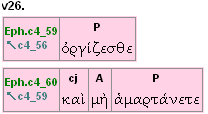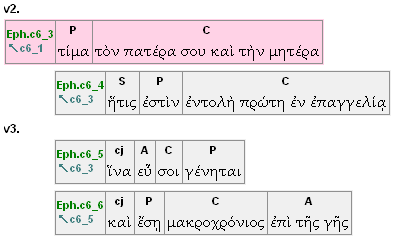One of the best ways to understand the OpenText.org annotation is to approach the Greek New Testament without allowing prior interpretations interfere with a fresh reading according to the text and grammar before your eyes. The following is a short tour through how the text and grammar was dealt with in the course of annotating the clauses in the Greek New Testament, which, it is hoped, will assist you in using our annotation in your own studies of the biblical text.
Since the verb is present in roughly three out of every four of the clauses in the Greek New Testament, identification of the verb is usually the first and most important task. The two main groups of exceptions are where the verb is omitted because a preceding verb is understood as shared and carried over from a previous clause and where we have a relational process ("to be" verbs are often without content and can be easily omitted). Annotate all verbal forms as P (for "predicator"). In addition, as a rule of thumb, group all words related to a verbal form together as a clause and analyze each clause with a separate verbal form separately.
In Ephesians 4:26 below for example, the two verbal forms "be angry" and "sin" are separated into two clauses. The conjunction "and" and the negative particle "not" (on "cj" and "A" see below) belong with the second verbal form "sin" and so are put in the same clause as it.

Since the subject is often not supplied, but is rather implied in the inflection of the verb (by means of person and number), you expect to find an explicit subject to annotate only less than half the time. When you see the grammatical subject of the verb in a clause (usually in the nominative case), you annotate it as S (for subject). In terms of function, the subject is the doer of the verbal action when you have an active or middle voice verb. When you have a passive voice verb, the subject is the recipient of the verbal action.
In the first example below (from 1 John 1:4), the subject, "we," are the doers of the action "write" (on "C" see below).

In the second example below (from 1 John 1:2), the subject is the recipient of the verbal action--"the life" is what "was revealed."

Besides a predicator and a subject, the remaining main components in a clause complete a verb by supplying the direct and indirect recipients of the verbal action or give additional circumstances (like when?, where?, how?, why?) associated with the verbal action. When you encounter the direct or indirect recipients to the verbal action (usually, but not always, in the accusative and dative case respectively), annotate them as C (for "complement"). When you meet adverbial circumstances associated with the verbal action (for instance, telling at what time, at what place, in what way or by what means, for what reason or for what purpose), annotate them as A (for "adjunct").
In the example below (from Ephesians 6:4), "your children" are the recipients of the exasperation forbidden and of the nurturing commanded. The circumstance of "how" is expressed by the prepositional word group, "in the discipline and instruction of the Lord." The negative particle, "not," is also annotated as a type of circumstance (thus A).

After you have identified the predicator, subject (if present), and any complements or adjuncts, the words left over are going to be inter-clausal conjunctions or vocatives. Annotate the conjunctions as "cj" and the vocatives as "add." From the same example from Ephesians 6:4 above, we see the conjunctions "and" and "but" annotated as "cj" and the vocative, "fathers," annotated as "add."
The most tricky part of the process is deciding on whether a clause is dependent on or should be embedded inside another clause. The rule of thumb is to annotate clauses with a finite verbal form and certain particles or conjunctions that indicate subornation as secondary clauses, clauses with a finite verbal form, but no subordinating particles, as primary clauses, and clauses with non-finite verbal forms (participles and infinitives) as embedded clauses. Genitive absolutes participial clauses and infinitive clauses beginning with a preposition plus article combination are also annotated as secondary clauses (rather than embedded clauses).
In the first example below (from Ephesians 6:2-3), the relative clause (beginning with relative pronoun, "which," the S in the relative clause) and the purpose clauses (beginning with the subordinating particle, "so that" and the second subordinating clause coordinated with the first by the conjunction "and") are secondary clauses even though they have finite verbal forms. The main difference is the presence of the relative pronoun and the subordinating particle respectively.

In the second example below (from Ephesians 6:14-15), the participial clauses are embedded clauses that function as adjuncts indicating how (in what way or by what means) the author expected his Ephesian audience to stand.

When you are working through the Greek New Testament, there is no shortage of difficulties and uncertainties as you try to account for everything you encounter. Perseverance and practice is the key to reading and understanding large portions of the Greek New Testament. You are invited to begin or continue your journey in reading the New Testament text in its original language with our annotation as a companion, sometimes as dialogue partner and sometimes as guide.





